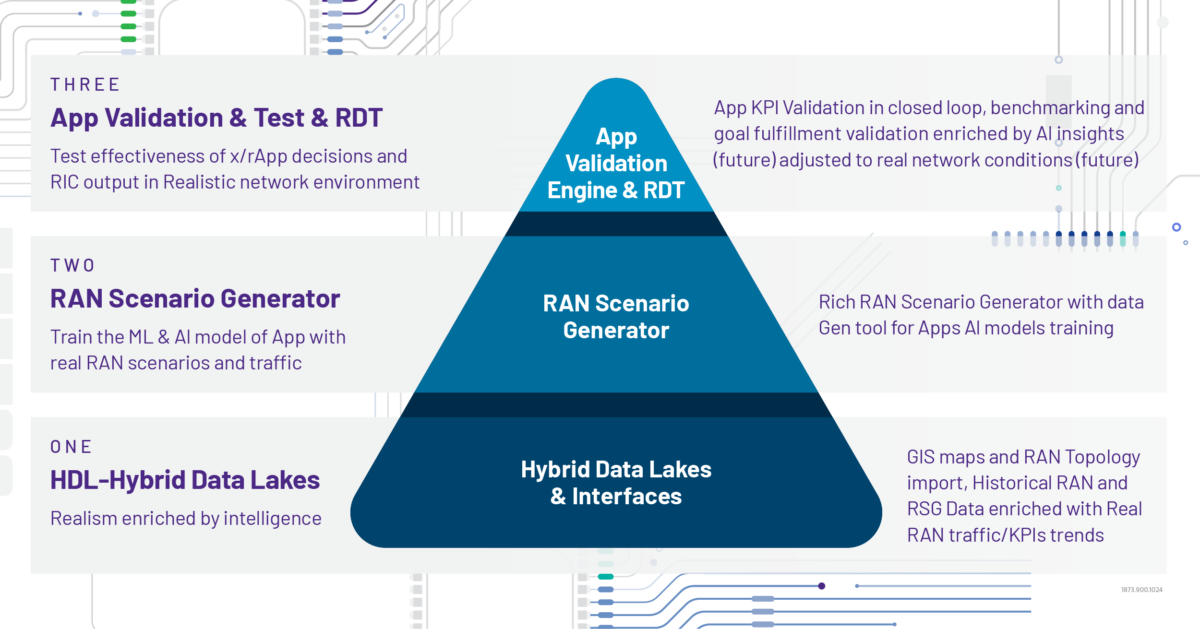VIAVI’s extensive portfolio of emulators can simulate every aspect of RAN networks, from purpose-built systems to 3GPP and O-RAN networks including future 6G /NTN and HetNet deployments. The RAN Scenario Generator (RSG) is a system-level RAN simulator specifically designed to validate and benchmark the emerging Open RAN ecosystem, particularly the RAN Intelligent Controller (RIC), in both near-real-time and non-real-time scenarios. Additionally, it can generate RAN specific data sets which can be used to train AI/ML models of intelligent AI-driven RAN applications such as SON, rApps, xApps and more.
The RSG accurately simulates system-level RAN behavior, creating a RAN Digital Twin (RDT) that mimics real network conditions and behaviors. This powerful solution can emulate various topologies, configurations, mobility patterns and traffic profiles on both real and synthetic maps. Supporting 4G, 5G, emerging 6G and NTN networks, the AI RSG unlocks endless possibilities to train AI-driven models for optimization of technologies like massive MIMO, making it essential for advanced network performance.

Scalability
The TeraVM AI RSG can simulate up to 10,000 user equipment (UEs) and between 1,000 and 5,000 cells per reference server. It can be deployed in Docker containers within cloud environments or on dedicated servers. The scale depends on the specific use case, with the ability to generate data at various granularities, from one minute to daily intervals for many weeks and even months. The tool’s scalability matrix helps define parameters for different scenarios.
Use Cases and Capabilities
Users can import real-world maps with streets, buildings and network configurations to create UE profiles that simulate movements, handovers and resource requests. Traffic demand profiles can also be generated, enabling UEs to switch between idle and active states while consuming varying amounts of Physical Resource Blocks (PRBs). Layer 1 radio conditions are modeled and fed into the Layer 2 scheduler, which assigns PRBs based on the Channel Quality Indicator (CQI). AI RSG supports various scheduling types and allows users to introduce anomalies like interference to study their effects on signal-to-noise ratio (SNR) and throughput.
- MU-MIMO: The AI RSG supports Layer 1 simulation with active antennas and various beamforming techniques, including analog, digital and hybrid methods. It accommodates different types of active antennas with configurable arrays for beamforming, such as SSB and CSI-RS. The RSG can simulate real neighborhoods by importing detailed descriptions of buildings and materials. Initially a synthetic simulator, it now supports various indoor coverage methods in accordance with the 3GPP standard (TS 38.901). The tool has been successfully utilized by Tier 1 customers developing massive MIMO use cases.
- Non-Terrestrial Networks: The RAN Scenario Generator is enhancing its capabilities by integrating support for Non-Terrestrial Networks (NTN), complementing its terrestrial network features. This addition provides essential NTN KPIs for machine learning (ML) training, optimizing satellite resource usage while factoring in costs and bandwidth. The RSG facilitates ML model training for efficient handover decisions between NTN and terrestrial networks, ensuring smooth and cost-effective transitions. Additionally, the AI RSG includes an NTN Planning Tool that addresses emergency handover scenarios, capacity planning and IoT coverage, making it a comprehensive solution for advanced network planning.
- RAN Intelligent Controller: The AI RAN Scenario Generator offers a cost-effective solution for training r/xApps across various network scenarios. By emulating diverse traffic patterns and user behaviors, it exposes r/xApps to real-world RAN conditions, preparing them for live deployment. The tool can simulate dynamic environments by controlling user movements, user counts and service usage at different times, all while accounting for changing radio conditions and their impact on resources and scheduling. This dynamic simulator operates in a closed loop, interacting with applications and mimicking the entire network’s behavior.
- AI Optimization: Integrating real network traffic patterns and KPIs enhances realism, transforming the system into a comprehensive Digital Twin that reflects the operator’s actual network, fully training AI/ML optimization algorithms for improved performance.
The AI RAN Scenario Generator (RSG) offers a flexible and complete solution for current and future network testing and optimization, equipped with data exposure, integration and an app validation engine. As networks evolve, VIAVI is committed to expanding the tool’s capabilities to meet these growing demands. The progression from the AI-enabled RSG to a fully developed RAN Digital Twin reflects VIAVI’s ongoing innovation and technological advancements.